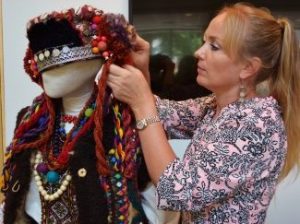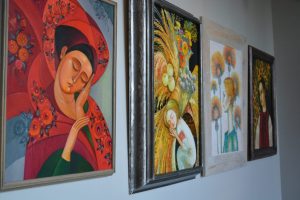‘Image of Ukraine’: UNC Exhibition Celebrates Traditional Ukrainian Arts
September 6, 2017
UNC Global Affairs

Artist Lesia Zintchouk adjusts a headpiece on a traditional Ukrainian ensemble, on display at the FedEx Global Education Center as part of the "Image of Ukraine" exhibition. Photo by Myra Jo '17.
Image of Ukraine (Образ України): Exploring Ukrainian Culture through Embroidery and Painting highlights two traditional Ukrainian folk art forms: vyshyvka, Ukrainian embroidery, and Petrykivka, a Ukrainian style of painting named after its city of origin. On display at the FedEx Global Education Center at the University of North Carolina at Chapel Hill through December 8, 2017, the exhibition explores Ukrainian culture through the lens of decorative folk art, delving into the history and cultural significance of traditions central to the lives of Ukrainian families in North Carolina and Ukraine.
After Ukraine became an independent country in 1991, a large influx of immigrants came to the United States, particularly North Carolina. In 2002, a group of Ukrainian immigrants created a community for North Carolinians of Ukrainian descent, the Ukrainian Association of North Carolina, one of the organizers of the exhibition and a partner of the UNC Center for Slavic, Eurasian and East European Studies in prior lectures, talks and cultural programs.
Oleh Wolowyna was one of the original founders and the first president of the organization.
“The purpose [of the association] is to have a way for people of Ukrainian ancestry that live in the states to get together and celebrate the culture of their mother country, and to inform Americans about Ukraine and its culture and history,” Wolowyna said. With Image of Ukraine, the association is staying true to this mission.
“We always look for opportunities to work with the local community to create cultural programming and globally relevant exhibits. Collaborating with the Ukrainian Association of North Carolina became a wonderful opportunity to bring Ukrainian culture to campus,” said Ingrid Smith, manager of global events and exhibitions for UNC Global.
The exhibition includes numerous examples of traditional embroidery from regions across Ukraine, as well as paintings in the style of Petrykivka. These visually rich displays are complemented by interviews with members of the Ukrainian community in North Carolina. Many of them have loaned personal items on display, including family heirlooms that have survived sociopolitical upheavals and wars over the past century.

Featured painter Olena Zintchouk’s life story is just one example of how conflict and political change has shaped the lives of Ukrainians.
Born in Petrykivka in Eastern Ukraine, Zintchouk is a master of the Petrykivka style. In 1991, after the Soviet Union collapsed and Ukraine declared independence, Zintchouk and her husband, along with three other Ukrainian artists, were invited by the Ukrainian diaspora in Canada to demonstrate Ukrainian folk art. The tour inspired Zintchouk’s family to move to Canada.
After 17 years in Canada, Zintchouk found a new home in Wake Forest, North Carolina, closer to the couple’s daughter and grandchildren. Zintchouk has since returned to her artwork; her paintings reflect her immigration story and serve as a voice for other immigrant women.
Lesia Zintchouk is also an artist. Her interpretations of Ukrainian headpieces are on display, featured with traditional and reinterpreted regional outfits that she curated.
“I am humbled by my Ukrainian heritage,” said Lesia Zintchouk. “Growing up in the eastern part of Ukraine, my parents instilled in me the patriotic love of my homeland, even though it was forbidden…we pass down old recipes and retell old legends, dress up in vyshyvankas [long-sleeved embroidered shirts] for holidays, sing old songs, collect books, even paint traditional elements on the house. I was always surrounded by my parents’ art.”
Vyshyvka styles are as diverse as the natural landscapes and folklore of the region and date as far back as the Neolithic period. While the textiles created during this early period no longer exist, the evidence of ancient embroidery is carved into the bodies on some of the 300 stone statues called “Baba” that are scattered throughout eastern parts of Ukraine, erected around 4,000 BCE. Several are decorated with geometric designs resembling Ukrainian embroidery.
“Preparing for this exhibit, I have learned even more amazing facts about our culture,” Lesia Zintchouk elaborated. “I am excited and honored to showcase the beautiful artistry of Ukraine.”
A free public reception celebrating the exhibition will take place on September 14, 2017, beginning at 5:30 p.m. at the FedEx Global Education Center. The reception will feature a keynote lecture by Natalie Kononenko, professor and Kule Chair in Ukrainian Ethnography in the Department of Modern Languages and Cultural Studies at the University of Alberta in Canada, and will be followed by fashion demonstrations and Ukrainian food.
The FedEx Global Education Center, located at 301 Pittsboro Street in Chapel Hill, is open weekdays from 8:00 a.m. to 9:00 p.m. and on select Saturdays from 8:00 a.m. to 4:30 p.m.
The exhibition is hosted by UNC Global and was organized by the Ukrainian Association of North Carolina; the UNC Center for Slavic, Eurasian and East European Studies; and Global Relations at UNC. Additional support was provided by UNC’s Center for Global Initiatives, Department of American Studies and Department of Germanic and Slavic Languages and Literatures. Special thanks go to the Ukrainian American Club of Southwest Florida for allowing UNC to exhibit a number of framed embroidery pieces from their collection.
